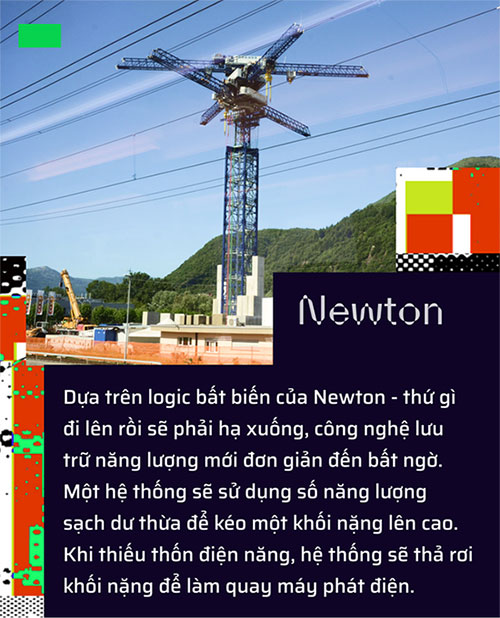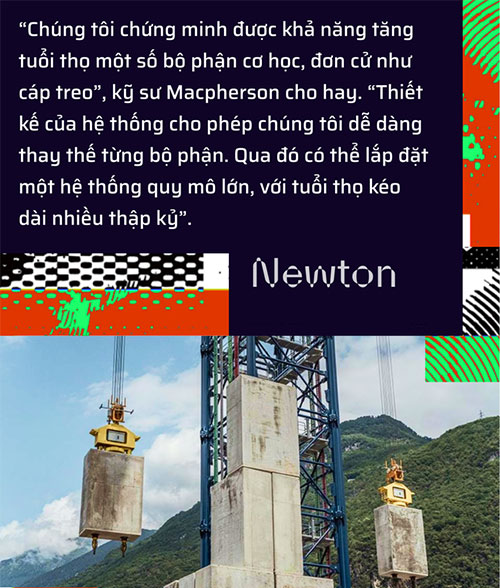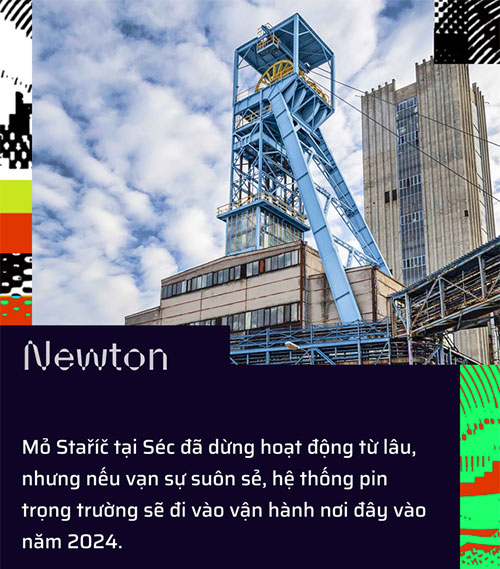The clean energy revolution is still grappling with a pressing question. When the wind blows, the waves crash, and the sun shines brightly on fields of golden flowers, the amount of electricity generated from clean systems is immensely abundant. But when the quiet winter night falls and silence envelops, what do we do to have electricity?
In 2021, we answered this question with a timeworn method: burning fossil fuels to power the global electric grid. We are using a solution from the last century to address the dilemmas of a new era, a solution that directly undermines efforts to reduce greenhouse gas emissions.
Energy storage devices are still hailed as the savior for the clean energy sector. Some experts aim to solve the problem with increasingly refined lithium-ion battery systems. Others believe that clean hydrogen is the future of the energy industry. However, a third opinion has emerged, seeking to harness the invisible power that exists around us: gravity.

This method of generating electricity is somewhat similar to existing hydropower technology, which accounts for up to 90% of global electricity production. When there is an energy surplus, pumps push water up to reservoirs, waiting for the dry moments to come. The water is then released to spin turbines and generate electricity when needed.
In most countries, we have seen how successful hydropower models can be; however, issues arise as the scale of the dam increases.
Hydropower projects can generate enormous amounts of energy, but due to high costs and stringent requirements—extensive terrain alongside a massive water source—hydropower dams cannot exist everywhere. To achieve the goal of eliminating carbon emissions, we need an energy storage system that can be located anywhere and built at any scale.
The clean energy startup Gravitricity aims to make this dream a reality. Last April, the team successfully created a prototype device called a “gravity battery”: a 15-meter high steel tower that suspends a 50-ton weight. Using surplus clean energy, an electric motor slowly lifts the weight high, then releases it to spin a turbine and generate electricity when necessary.
Despite the seemingly large numbers of 15 and 50, Jill Macpherson, a senior engineer at Gravitricity, asserts that the scale of this gravity battery system is still small. Nevertheless, the 15-meter tower can immediately generate 250 kW of electricity, enough to power 750 households for a brief moment. During testing, the team recognized the long-term potential of the system.

The tower’s height contradicts Gravitricity’s current goal of finding a way underground. Throughout 2021, the startup’s engineers scoured abandoned coal mines in the UK, Eastern Europe, South Africa, and Chile. Gravitricity’s director, Charlie Blair, simply explains: “Why build a tall tower when we can use the Earth’s geology to bear some of the weight?”
It seems that the two pieces fit together perfectly. The Earth is riddled with abandoned mining shafts. At depths of 300 meters or more, these shafts could accommodate multiple large-scale systems from Gravitricity. The project becomes even more feasible as lawmakers express a willingness to abandon fossil fuels. With sufficient funding and a bit of luck, the first trial gravity battery will be operational in the Czech Republic by 2024.
First, engineers must address a series of challenges
“We need to thoroughly examine the existing equipment structures to ensure safety and the ability to lift weights up to several thousand tons,” Mr. Blair said. “There are also safety regulations concerning methane gas and potential flooding in mines.”
After considering these issues, Gravitricity is contemplating the step of intentionally flooding * its equipment. This method may incur initial costs, but it has the potential for long-term stability.

While Gravitricity is exploring the Earth’s crust, others still harbor ambitions of building tall towers. In the southern valley of Switzerland stands a concrete and steel structure from Energy Vault, a leading company in gravity battery production. Their tower is equivalent in height to a 20-story building.
Whenever there is a surplus of clean energy, an AI-controlled crane lifts a 30-ton weight high. When supply exceeds demand, the weight gradually descends, generating enough energy for thousands of homes.
With proven technology in hand and receiving up to $402 million in funding (approximately 9.3 trillion VND), Energy Vault is ready to enter the commercialization phase. With ample funds, the company is investing in aesthetics, planning to build a structure that is less angular than the prototype tower, capable of controlling a weight of several thousand tons on a cable and pulley system. They have named the project “EVx.”
“Imagine a warehouse filled with electricity-generating elevators,” explains Robert Piconi, CEO of Energy Vault. “When clean electricity comes in, the weights made from recycled materials are lifted high, and when the grid needs energy, they come down. An EVx tower capable of generating 100 megawatt-hours of energy could supply electricity to 25,000 homes in a day.”

The size and design of each tower will determine their energy capacity. According to the CEO, the smallest tower will still occupy tens of thousands of square meters (equivalent to several dozen Mỹ Đình National Stadiums, if not more). Mr. Piconi does not downplay the seriousness of the issue, as gravity battery towers are often located near clean energy farms, which are situated far from residential areas.
Word is spreading, as more and more companies are placing orders for gravity towers, with requests pouring in from the USA, Europe, the Middle East, China, and Australia. As China, the world’s largest greenhouse gas emitter, decides to change, the transition from fossil fuels to clean energy will become more solid.
Addressing challenges in grid balance
Although the prospect remains distant (and too beautiful to become a reality soon), countries will eventually need to find a method for storing clean energy. Everyone will require a long-term storage solution that can provide instant energy when the grid demands it.
The second requirement is hindered by one of the long-standing challenges facing the clean energy sector. Modern electrical grids were not designed for renewable energy systems.

The weight of the heavy mass combined with a slow descent will create a significant torque, allowing the gravity battery system to generate maximum energy almost instantly. This enables the system to deftly maintain the balance of the grid, reducing the risk of damaging infrastructure and bringing down the grid.
Where does Lithium fit into the bigger picture?
Lithium batteries, which power our phones, laptops, and electric vehicles, are being produced in increasing quantities and at decreasing costs. Moreover, the performance of lithium batteries is similar to that of potential gravity battery systems. Why not design a massive lithium battery system for energy storage?
To answer this question, we can consider the lifecycle cost of a device. Gravity batteries are mechanical structures that can fail over time and in various ways. Failures and degradation can stem from cable breaks, gear jams, rust, but they do not affect the overall structure. Individual components can be easily replaced, allowing gravity batteries to have a lifespan of up to 50 years.

However, lithium batteries with their chemical composition face far more complex issues. “Lithium-ion energy cells degrade, meaning that the battery capacity decreases over time and cannot be recovered,” says Asmae Berrada, an energy storage expert at the International University of Rabat in Morocco. She has published research showing that the lifecycle cost of lithium-ion batteries is nearly double that of a towering gravity battery.
Adding to the fact that lithium-ion batteries face sensitive issues such as ethical and environmental concerns, Ms. Berrada believes that solutions “not requiring lithium” are essential for clean energy storage. Currently, she and her colleagues are developing a clean energy storage system utilizing water and gravity, which has received financial backing from the governments of Spain and Morocco.
Instead of lifting and lowering a heavy mass weighing thousands of tons, the surplus clean energy will be used to raise a piston submerged in water; the deeply submerged piston will push water to make the turbine operate. A similar method is being tested in Germany and the United States.
Conclusion
It is difficult to assert the success of gravity battery towers. However, at the same time, we cannot underestimate its innovative impact in exploring new energy storage methods.
Currently, we do not possess a comprehensive optimal method, but with the potential to harness the intriguing interactions that exist throughout the Earth, energy storage towers in the form of heavy weights suspended high will remain an innovative solution worth exploring.


















































